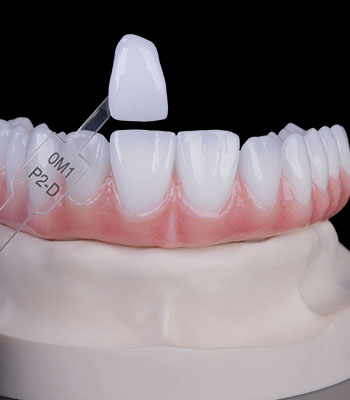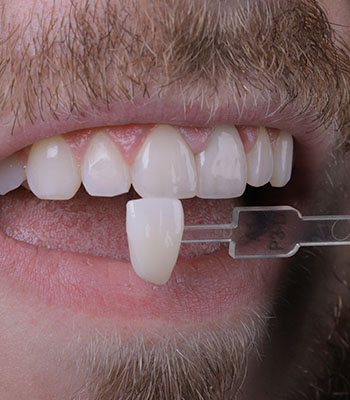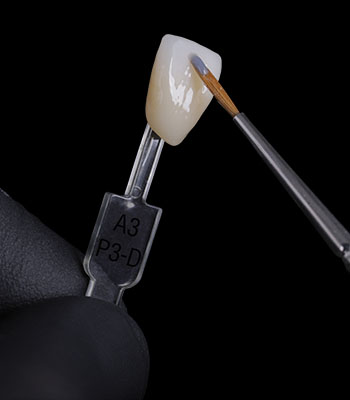Zirkonzahn Shade Guides
Monolithic Prettau® zirconia shade guides identical to the final restoration
Zirkonzahn Shade Guides determine precise patient tooth shade and optimal Prettau® Dispersive® material selection with monolithic zirconia sample teeth. The colour spectrum is inspired by the VITA classic range, comprised of 16 dentine shades (A1-D4) and 3 Bleach shades. The sample teeth are monolithic and glazed with 3D Base Glaze glaze material. Colour theory shows that shape and surface structure considerably influence the colour effect. Striving for perfection, we build our shade guides in all respective Prettau® Dispersive® zirconia materials in the shape of a premolar as well as upper and lower incisor.
One-to-One Function: If the material of the shade guide and the material of the zirconia crown are identical, it is ensured that the colour of the zirconia restoration corresponds 1:1 with the natural tooth colour of the patient. For individualists, the shade guides in the shape of an upper incisor are also available with minimally reduced, sintered sample teeth (minimal cutback), which can be further characterised by the application of different incisal materials. This results in truly unique shade guides that exactly reflect the individual approach and own aesthetic demands.
Overview of the characteristics
 |
Zirconia shade guides with monolithic sample teeth in the shape of a premolar as well as upper and lower incisor made of Prettau® 2 Dispersive®, Prettau® 3 Dispersive®, Prettau® 4 Anterior® Dispersive® zirconia for a precise, material-identical determination of the patient's tooth colour. The shade guide is made of the same material and colour as of the final restoration. This guarantees that the colour final restoration will be 100% identical to the selected one. | |
 |
Very accurate reproduction of the colour and translucency values of the different Dispersive® zirconia types. One-to-One Function for all monolithic zirconia restorations (veneers, crowns, bridges) | |
 |
Individual Shade Guides: Shade guides with sintered, minimally reduced sample teeth in the shape of an upper incisor (minimal cutback) can be individually characterised | |
 |
For the dental practice, we recommend using our specially developed Zirkonzahn Shade Guide Prettau® Line in the shape of a premolar as well as a lower and upper incisor, to identify easily the natural tooth colour. | |
 |
Colour spectrum: 19 colours (A1-D4 including 3 Bleach shades, inspired by the VITA colour range) | |
 |
Transparent, metal-free sample bars made of temperature-resistant plastic to avoid interference caused by translucent metal (metal sample bars would shine through under the zirconia material) | |
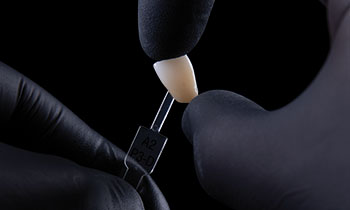 |
Sample teeth can be placed in any position without shifting thanks to a special 360° locking mechanism | |
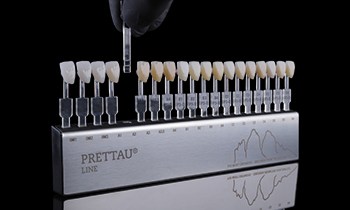 |
Simply practical: stainless steel holder with all important processing information. |
Zirkonzahn Shade Guides
 |
 |
 |
 |
|||
| Zirkonzahn Shade Guide Tooth 11 |
Zirkonzahn Individual Shade Guide Tooth 11 |
Zirkonzahn Shade Guide Tooth 31 |
Zirkonzahn Shade Guide Tooth 25 |
|||
| Zirconia shade guide for the upper jaw | Zirconia shade guide for the upper jaw with minimal cutback | Zirconia shade guide for the lower jaw | Zirconia shade guide for the posteriors | |||
 |
Prettau® Line | Núm. do produto: SGAA0401 Já está disponível |
Núm. do produto: SGAA0411 Já está disponível |
Núm. do produto: SGAA0402 Já está disponível |
Núm. do produto: SGAA0403 Já está disponível |
|
 |
Prettau® 2 Dispersive® | Núm. do produto: SGAA0101 Já está disponível |
Núm. do produto: SGAA0111 Já está disponível |
Núm. do produto: SGAA0102 Já está disponível |
Núm. do produto: SGAA0103 Já está disponível |
|
 |
Prettau® 3 Dispersive® | Núm. do produto: SGAA0201 Já está disponível |
Núm. do produto: SGAA0211 Já está disponível |
Núm. do produto: SGAA0202 Já está disponível |
Núm. do produto: SGAA0203 Já está disponível |
|
 |
Prettau® 4 Anterior® Dispersive® | Núm. do produto: SGAA0301 Em breve |
Núm. do produto: SGAA0311 Em breve |
Núm. do produto: SGAA0302 Em breve |
Núm. do produto: SGAA0303 Em breve |

On request, the front side of the shade guides can be personalised with the name of the dental practice and the back with the name of the dental laboratory (at extra charge).
DOWNLOAD BROCHURE
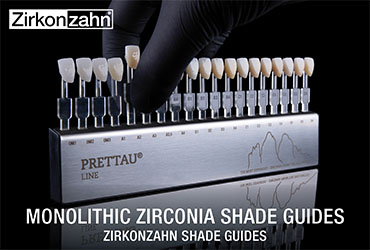 |
||||
 |
Brochure Zirkonzahn Shade Guides | |||
Colour spectrum
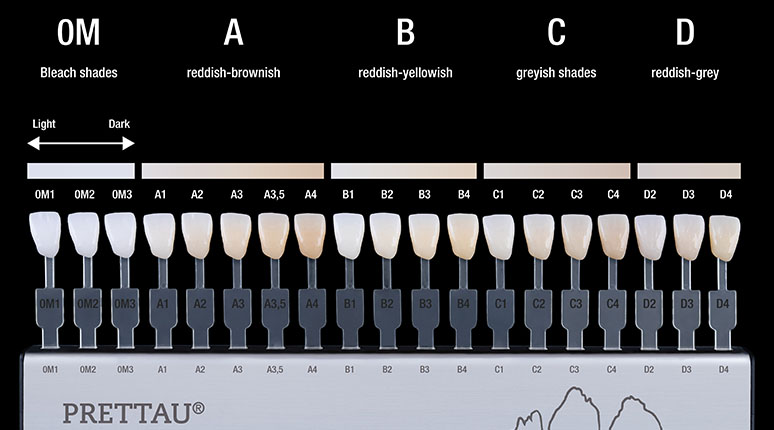
Mirror of time and lifestyle
The teeth are a mirror of a person’s life and individual lifestyle. They are different from person to person and disposition, lived years, nutrition and habits of each human being shape a unique appearance of wear patterns, degrees of translucency and colouring. The colour of a tooth is formed by the combination of dentine and enamel. In youth and when the person is in healthy growth, the dentine has a uniform colour. With increasing age, discolouration occurs, which usually manifests itself as darker areas in the dentine area. The overlying enamel, which is firmly bonded to the dentine, is characterised by varying degrees of opacity depending on the respective area - from whitish opaque to almost transparent. Overall, the tooth tends to have a single shade, with a higher translucency level towards the incisal edge.
South Tyrolean Dolomites - source of strength & inspiration
The white, rugged and ancient Dolomites, unique of their kind, rise up from the enormous primordial sea of Tethys 250 million years ago. Lifted with strength by the hard coral reefs of the African continent, they stand proudly against the infinite sky, challenging all weather conditions.
Famous today as a UNESCO World Natural Heritage, the Dolomites, located in South Tyrol, are a unique mountain range, an exceptional phenomenon in the Alps. Respected as a magical place in the Stone Age, they are still shrouded in their mystical charm. Their white colour lives on through the centuries, shining brightly in the moonlight and reverberating the glowing colours of the setting sun. This is the myth. These are the Dolomites - a source of strength and timeless inspiration. As unique as this natural monolith, is zirconia the dental material of choice. To imbue it with unique properties. To improve it. To make it resistant beyond our lifetime. To infuse luminosity and all its extraordinary attributes, gives us, as producers of this noble material, inspired by our South Tyrolean homeland and scientific spirit, the unbelievably immense feeling of doing the right thing.
Famous today as a UNESCO World Natural Heritage, the Dolomites, located in South Tyrol, are a unique mountain range, an exceptional phenomenon in the Alps. Respected as a magical place in the Stone Age, they are still shrouded in their mystical charm. Their white colour lives on through the centuries, shining brightly in the moonlight and reverberating the glowing colours of the setting sun. This is the myth. These are the Dolomites - a source of strength and timeless inspiration. As unique as this natural monolith, is zirconia the dental material of choice. To imbue it with unique properties. To improve it. To make it resistant beyond our lifetime. To infuse luminosity and all its extraordinary attributes, gives us, as producers of this noble material, inspired by our South Tyrolean homeland and scientific spirit, the unbelievably immense feeling of doing the right thing.
Tips for avoiding possible disturbing influences
- Ideally, colour determination should be carried out under natural daylight conditions or in a room illuminated with standardised daylight lamps; avoid direct, bright light (approx. 2000 lux, a well-lit dental chair already has approx. 8000 lux)
- Carry out colour determination quickly and no longer than 5-7 s: The human eye tires quickly when looking at something with concentration. This also affects the colour perception.
- Colour matching in a neutral colour environment, on a patient without make-up who is wearing neutral-coloured clothes - The perception of an intense colour influences the colour perception of another colour, which is observed immediately afterwards (simultaneous contrast), the colour of the underground also affects the perception of a colour.
- Participation in a colour matching course - When determining the patient's tooth colour, the exclusion of sources of interference and the individual experience level are of considerable importance. Participation in a special training course can be very helpful.
Steps of tooth shade determination
- Clean natural teeth well before determining the tooth colour, if necessary carry out a dental cleaning. The teeth surfaces do not have to be dried out, otherwise the teeth will appear too white.
- Carry out colour determination with relaxed lip position, ideally under daylight conditions (slightly cloudy sky) around 10-11 am or 2-3 pm or under standardised daylight illumination.
- Hold the corresponding Prettau® 2 Dispersive®, Prettau® 3 Dispersive® or Prettau® 4 Anterior® Dispersive® shade guide at a distance but still as close as possible next to or under the corresponding natural patient tooth (tooth neck to tooth neck or incisal edge to incisal edge)
- Hold the Zirkonzahn Shade Guide 11 for the upper jaw against the natural teeth to determine the natural tooth shade for a monolithic upper jaw structure to be fabricated in Prettau® Dispersive® zirconia or to check the interplay with the natural residual teeth in the upper/lower jaw or the interplay with an already fabricated zirconia lower jaw structure.
- Hold the Zirkonzahn Shade Guide 31 for the lower jaw against the natural teeth to determine the natural tooth shade for a monolithic lower jaw structure to be fabricated in Prettau® Dispersive® zirconia or to check the interplay with the natural residual teeth in the upper/lower jaw or the interplay with an already fabricated zirconia upper jaw structure.
- Hold the Zirkonzahn Shade Guide 25 for the posterior area against the natural teeth to determine the natural tooth shade in the posterior region and the shade effect on the occlusal surfaces.
- Disinfect the shade guides after use, allow to dry and store them in the supplied packaging, protected from direct sunlight.
- Examination of the fabricated monolithic zirconia structures ideally in industry standard daylight D65 with a correlated colour temperature of 6500 K.
 |
 |
 |
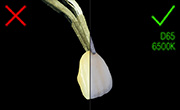 |

